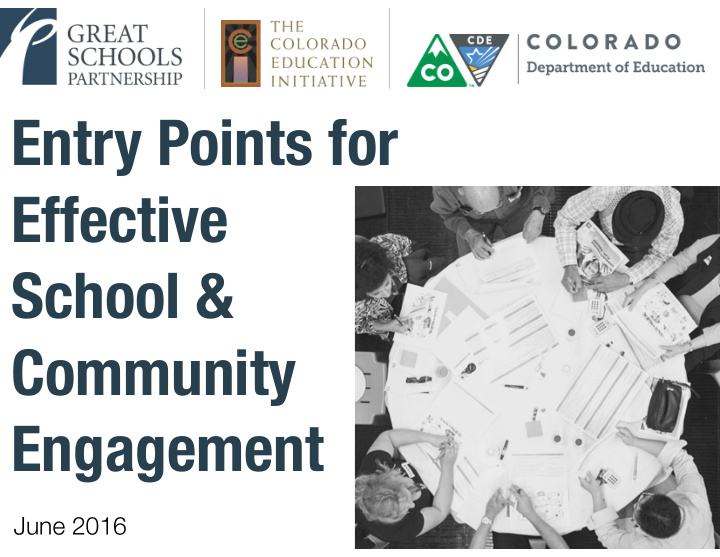



Entry Points for Effective School & Community Engagement June 2016
Agenda Overview and Outcomes A Tale of Two Approaches to Engagement Coming to Common Understandings • The Engagement Spectrum • E ff ective Engagement Exploring Entry Points for Engagement
Outcomes To build a shared understanding of authentic school-community engagement
Outcomes To articulate the rationale for community engagement in schools and districts
Outcomes To identify principles of effective engagement
Outcomes Explore entry points for engagement work and planning in districts and schools.
A Tale of Two Approaches to Engagement
Coming to Common Understandings
QUESTION 1 (5 min) What does authentic community engagement mean to us? QUESTION 2 (5 min) Why do you think community engagement is important for school districts?
Principles of Successful Engagement 1. Inclusive and equitable 2. Intentional 3. Connected to decision-making and change
What Do People Want? 1. To belong 2. To have a legitimate voice 3. To have an impact
Positive Outcomes Stronger and more trusting relationships
Positive Outcomes New youth, family, and community leaders
Positive Outcomes Innovative solutions to vexing problems
Positive Outcomes Greater community support for change
Engagement = Inclusion
Engagement Decision Making Action Organizing Change Engagement
Engagement Spectrum Informing Seeking Input Deciding Together More school Less school directed directed Less community More community involvement involvement
Critical Considerations •What is the intent of the selected strategy? •To what extent is it scaffolding the schools and community toward a larger goal for engagement? •How well do the strategy, the goal, and the communications align with one another?
Mapping Entry Points
Defining “Entry Point” An existing policy, program, or practice that can be modified to amplify stakeholder voice and involvement in district/school decision-making, enhance understanding of the principles and value of authentic engagement, and help people see the transformative potential of larger engagement driven systems change.
Defining “Entry Point” *Quick wins: Small “winnable” successes that can be achieved relatively quickly and cheaply to help people see the transformative potential of larger investments in authentic engagement.
Examples •Parent-teacher conferences •Exhibitions of learning •Student governance •Surveys (parent, teacher, student, community) •Open houses + orientation programs •Community-based/service learning projects •School board meetings
Conditions to look for: •It intersects with and impacts teachers, students, families, nonprofits, service providers, businesses, cultural groups, voters, etc. •It can influence governance, authority, and decision-making
Conditions to look for: •Impact can be achieved without significant investments of time, money, resources •The change will be visible to and felt by people inside and outside of the school
Feasibility •Is short-term success likely? Can success be achieved in a manageable period of time? •Will the change be supported by school leaders, families, and the community?
Feasibility •Can the district/school find or allocate the capacity required to coordinate the work? •Is “a coalition of the willing” already in place? Can a coalition be assembled? •Can community assets be leveraged to increase necessary capacity or resources?
Relevance •Does the entry point impact multiple constituencies and stakeholders? •Will the entry point influence governance, authority, and decision- making? •Is there urgency? Is it enough to bring people to the table without creating a sense of crisis?
Relevance •Is it “sacred” to educators and/or the community? Will it create tension or confusion? •What might the consequences be if the reengineering work is unsuccessful?
A ff ordability •What level of time, funding, human resources, or political capital will be required to achieve the desired impact? •Is the investment worth the potential gain? What is the likely return on the investment?
A ff ordability •Can the change be sustained with a reallocation of existing time, funding, and resources? •Or will sustainability require new, additional, and/or permanent resourcing?
Influence •Is the change likely to pave the way for more meaningful modifications to other policies, programs, and practices? •Does it have the potential to shift the mindsets and overcome the biases of educators, students, families, and community members?
Influence •Could it lead to significant changes in school culture and governance? •Will improvements lead to positive changes in learning experiences and pedagogy?
Narrative •Is the rationale for the change compelling and easy to understand? •What rationale will appeal to busy educators and their needs, interests, and aspirations? •Does the change have the potential to inspire and motivate?
Narrative •Will it challenge and overturn entrenched narratives that stakeholders have about themselves and others? •Will it positively impact internal and external perceptions?
Planning for Engagement: Entry Points
Feedback on the Process
Reflection and Closing
Recommend
More recommend